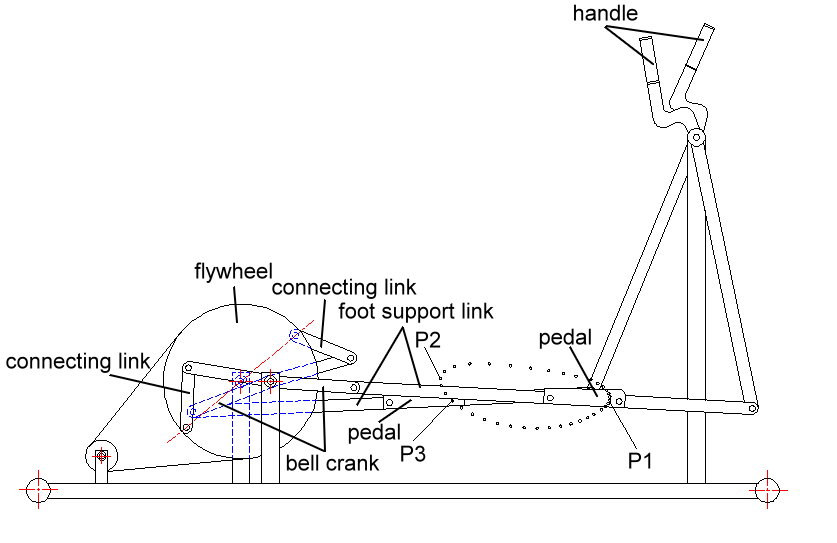On the Mechanism Design of an Innovative Elliptical Exerciser with Quick-Return Effect
Keywords:
mechanism design, quick-return mechanism, elliptical exerciserAbstract
The objective of this study is to propose and investigate an innovative elliptical exerciser with quick-return effect that mimics the timing of the foot trajectory while jogging. At first, the innovative mechanism of the elliptical exerciser with quick-return effect is proposed. The structure and function of the proposed design are introduced. Then, the mechanism is analysed kinematically using the vector-loop method and motion geometry of the mechanism. An illustration is presented for explaining the design procedure of the proposed innovative design. Finally, the pedal trajectory of the innovative elliptical exerciser is simulated. The simulation results validate that the motion of pedal trajectory on the striding travel is faster than that on the supporting travel. Because of this quick-return effect, the timing of the pedal trajectory meets the principles of ergonomics and prevents the user suffering from muscle sore, pain or even injury.
References
G. H. Martin, Kinematics and dynamics of machines, 2nd ed., New York: McGraw-Hill, 1982.
H. S. Yan, Mechanisms: theory and applications, New York: McGraw-Hill, 2016.
S. N. Dwivedi, “Application of a Whitworth quick return mechanism for high velocity impacting press,” Mechanism and Machine Theory, vol. 19, no. 1, pp. 51-59, January 1984.
F. O. Suareo and K. C. Gupta, “Design of quick-returning R-S-S-R mechanisms,” Journal of Mechanisms, Transmissions, and Automation in Design, vol. 110, no. 4, pp. 423-428, December 1988.
D. G. Beale and R. A. Scott, “The stability and response of a flexible rod in a quick return mechanism,” Journal of Sound and Vibration, vol. 141, no. 2, pp. 277-289, September 1990.
R. F. Fung and K. W. Chen, “Constant speed control of the quick return mechanism driven by a DC motor,” JSME International Journal, Series C, vol. 40, no. 3, pp. 454-461, September 1997.
R. F. Fung and F. Y. Lee, “Dynamic analysis of the flexible rod of a quick-return mechanism with time-dependent coefficients by the finite element method,” Journal of Sound and Vibration, vol. 202, no. 2, pp. 187-201, May 1997.
R. F. Fung and K. W. Chen, “Vibration suppression and motion control of a non-linearly coupled flexible quick-return mechanism driven by a PM synchronous servo motor,” Journal of Sound and Vibration, vol. 212, no. 4, pp. 721-742, May 1998.
F. J. Lin and R. J. Wai, “A hybrid computed torque controller using fuzzy neural network for motor-quick-return servo mechanism,” IEEE/ASME Transactions on Mechatronics, vol. 6, no. 1, pp. 75-89, March 2001.
F. J. Lin and R. J. Wai, “Adaptive and fuzzy neural network sliding-mode controllers for motor-quick-return servomechanism,” Mechatronics, vol. 13, no. 5, pp. 477-506, June 2003.
J. L. Ha, J. R. Chang, and R. F. Fung, “Dynamic analyses of a flexible quick-return mechanism by the fixed and variable finite-difference grids,” Journal of Sound and Vibration, vol. 297, no. 1-2, pp. 365-381, October 2006.
J. R. Chang, “Coupling effect of flexible geared rotor on quick-return mechanism undergoing three-dimensional vibration,” Journal of Sound and Vibration, vol. 300, no. 1-2, pp. 139-159, February 2007.
W. H. Hsieh and C. H. Tsai, “A study on a novel quick return mechanism,” Transactions of the Canadian Society for Mechanical Engineering, vol. 33, no. 3, pp.139-152, September 2009.
J. H. Shyu, C. K. Chen, C. C. Yu, and Y. J. Luo, “Research and development of an adjustable elliptical exerciser,” Advanced Materials Research, vols. 308-310, pp. 2078-2083, August 2011.
C. A. Nelson and J. M. Burnfield, “Improved elliptical trainer biomechanics using a modified Cardan gear,” Proc. ASME 36th Mechanisms and Robotics Conference, vol. 4, 2012, pp. 35-42.
J. P. Porcari, J. M. Zedaker, L. Naser, and M. Miller, “Evaluation of an elliptical exerciser in comparison to treadmill walking and running, stationary cycling, and stepping,” Medicine & Science in Sports & Exercise, vol. 30, no. 5, p. 168, May 1998.
J. Porcari, C. Foster, and P. Schneider, “Exercise response to elliptical trainers,” Fitness Management, pp. 1-3, August 2000.
H. Sozen, “Comparison of muscle activation during elliptical trainer, treadmill and bike exercise,” Biology of Sport, vol. 27, no. 3, pp. 203-206, August 2010.
L. Louie and Y. T. Lam, “A comparison on selected physiological variables between two models of elliptical cross trainers,” Asian Journal of Physical Education & Recreation, vol. 17, no. 1, pp. 91-103, April 2011.

Published
How to Cite
Issue
Section
License
Copyright (c) 2018 International Journal of Engineering and Technology Innovation

This work is licensed under a Creative Commons Attribution-NonCommercial 4.0 International License.
Copyright Notice
Submission of a manuscript implies: that the work described has not been published before that it is not under consideration for publication elsewhere; that if and when the manuscript is accepted for publication. Authors can retain copyright in their articles with no restrictions. Also, author can post the final, peer-reviewed manuscript version (postprint) to any repository or website.

Since Jan. 01, 2019, IJETI will publish new articles with Creative Commons Attribution Non-Commercial License, under Creative Commons Attribution Non-Commercial 4.0 International (CC BY-NC 4.0) License.
The Creative Commons Attribution Non-Commercial (CC-BY-NC) License permits use, distribution and reproduction in any medium, provided the original work is properly cited and is not used for commercial purposes.


.jpg)


